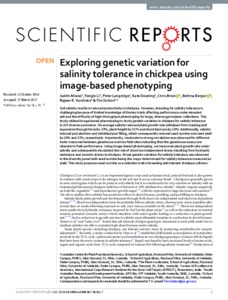Exploring genetic variation for salinity tolerance in chickpea using image-based phenotyping
Abstract
Soil salinity results in reduced productivity in chickpea. However, breeding for salinity tolerance is challenging because of limited knowledge of the key traits affecting performance under elevated salt and the difficulty of high-throughput phenotyping for large, diverse germplasm collections. This study utilised image-based phenotyping to study genetic variation in chickpea for salinity tolerance in 245 diverse accessions. On average salinity reduced plant growth rate (obtained from tracking leaf expansion through time) by 20%, plant height by 15% and shoot biomass by 28%. Additionally, salinity induced pod abortion and inhibited pod filling, which consequently reduced seed number and seed yield by 16% and 32%, respectively. Importantly, moderate to strong correlation was observed for different traits measured between glasshouse and two field sites indicating that the glasshouse assays are relevant to field performance. Using image-based phenotyping, we measured plant growth rate under salinity and subsequently elucidated the role of shoot ion independent stress (resulting from hydraulic resistance and osmotic stress) in chickpea. Broad genetic variation for salinity tolerance was observed in the diversity panel with seed number being the major determinant for salinity tolerance measured as yield. This study proposes seed number as a selection trait in breeding salt tolerant chickpea cultivars

